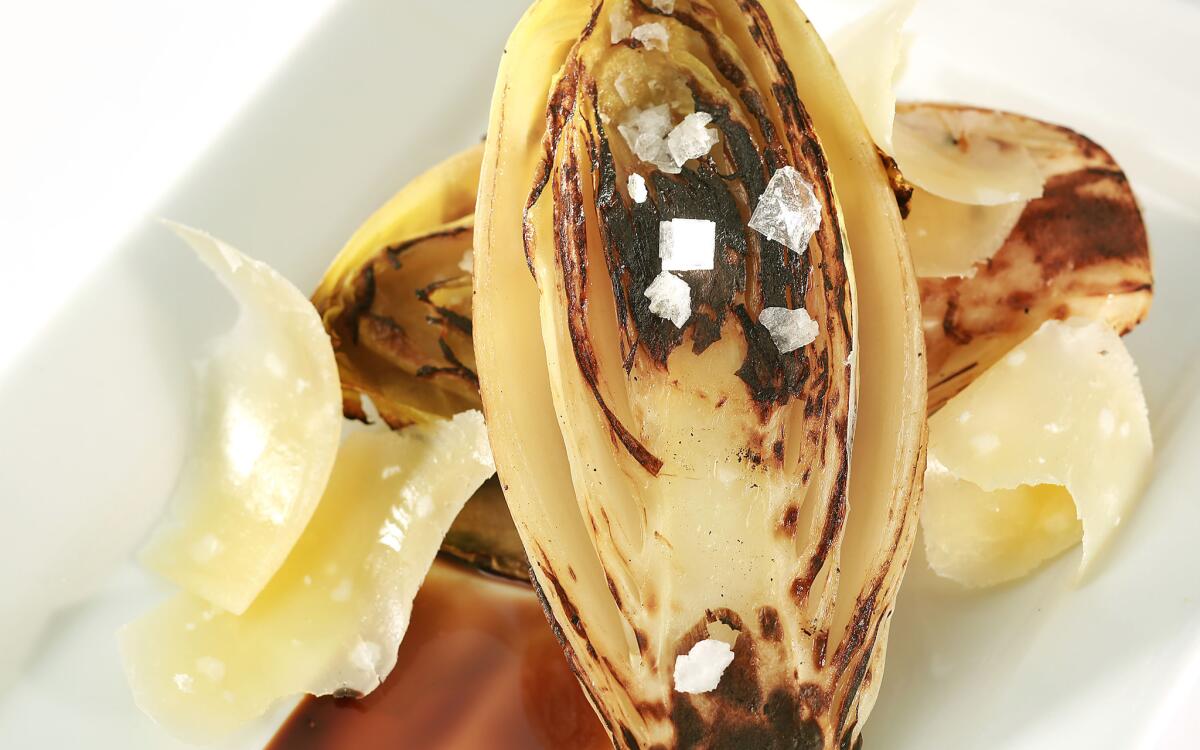Charred endive with balsamic and shaved Parmigiano-Reggiano

Here in Southern California, it’s funny to think of winter greens as even having a season. Stroll the produce aisle of your local supermarket pretty much year-round, and you can find vibrant bunches of rainbow chard or frilly escarole, the broad waxy leaves of pale green collards or delicate beet tops, their colorful stems a flamboyant extension of the roots.
But winter months are when local vegetables thrive and are at their peak, with sweeter leaves and superior flavor nurtured by colder weather. You can see the differences between year-round imports and seasonal greens best, of course, at local farmers markets. Right now, look for cabbages such as kale, members of the chicory family such as endive and escarole, as well as spinach, chard, beet and turnip greens, mustard and collard greens, and broccoli greens.
All too often, winter greens get a bad rap. They’re considered overly assertive and aggressive. The word “bitter” gets thrown around a lot. But treated properly, the greens can add a wonderful, even lively, dimension to a recipe. Which is why they’re so common in so many cuisines, such as the New Year’s staple of slow-cooked greens and black-eyed peas in the South, Chinese mustard greens quickly stir-fried with a touch of garlic and hot pepper, or slow-braised German cabbage. Consider winter greens as you might a relationship: Get to know them, treat them right and the rewards will be long-lasting.
Incorporate winter greens raw or cooked, depending on the variety and your tastes. Use small, tender leaves as a raw garnish or salad base. If the leaves are larger, or even the slightest bit tough, as with kale, massage them with a little vinaigrette or oil and salt; the rubbing tenderizes the leaves, as with cooking, and mutes their dominant notes. And if you’ve grown weary of kale lately, just think beyond smoothies and kale chips — the stuff is incredibly versatile.
Many winter greens adapt particularly well to grilling or charring. Halve or quarter a head of endive or escarole and throw it on the grill; the direct heat quickly caramelizes the leaves to bring out the vegetables’ sweetness. Some greens, such as chard or spigarello — a relative of the broccoli family often found in Italian cooking — can be quickly wilted or sautéed, or even added at the last minute to a soup or stew, lending bright color and only mildly aggressive flavor. Other varieties, such as mustards and older or larger-leafed vegetables, benefit from low and slow cooking, their peppery notes and tougher textures yielding with time.
You’ll find that many recipes call for separating the leaves from their thick stems before cooking. Fibrous stems break down more slowly than the more delicate leaves, which is why many preparations involve cooking the stems first, then adding the greens toward the end of the recipe.
Even the toughest winter greens require delicate care, and you’ll want to use them within a day or so after bringing them home. Look for leaves that are crisp and vibrant and store the greens, unwashed and refrigerated in a plastic bag before using. Wash the greens well right before preparing, to get rid of any dirt or pests in the nooks and crannies.
The next time you bring home a bunch of colorful beets or turnip roots, save the tops. Consider cooking them or adding them to a salad — or more — for flavor and nutrients. And with the current focus on combating food waste, you might even feel virtuous — deservedly so.
noelle.carter@latimes.com
Twitter: @noellecarter
Heat a grill or cast iron pan over high heat until hot. Meanwhile, brush the endive pieces all over with a very light coating of oil. Char the pieces on all sides, 2 to 4 minutes. Serve the pieces drizzled with a little balsamic and curls of shaved Parmigiano-Reggiano, as well as a sprinkling of Maldon salt.
Get our Cooking newsletter.
Your roundup of inspiring recipes and kitchen tricks.
You may occasionally receive promotional content from the Los Angeles Times.
















